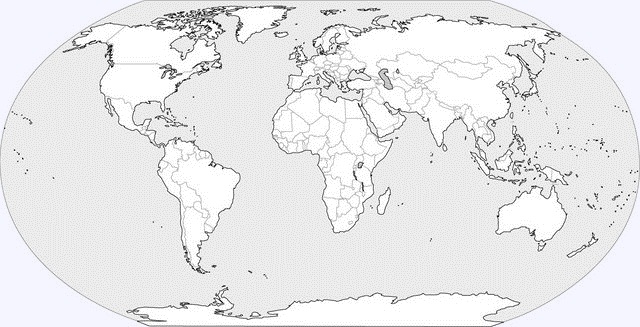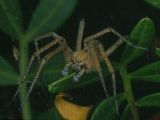|
Nombre común en ingles:
Six-eyed Sand,
Violin Spiders
Nombre común en castellano:
Se desconoce
Familias similares:
Género tipo:
Sicarius Walckeaer, 1847
Diagnosis:
Medium-sized to large araneomorph
spiders; two tarsal claws; ecribellate; haplogyne; six eyes in three
diads; semichelate chelicerae provided with a stridulating files.
Caracteres descriptivos:
Caparazón:
flat, as wide as long; integument hard, coriaceous (Sicarius); or
longer than wide with a conspicuous, deeply impressed fovea and
porrect clypeus (Loxosceles). Esternón:
wider than long (Sicarius) or longer than wide (Loxosceles). Ojos:
six; arranged in three diads in a recurved row. Quelíceros:
joined basally; laminate; semichelate: without condyle; outer
surface with stridulating file which is scraped by peg-like
processes on inner surface of palpal femora; fangs short, more or
less transverse. Piezas bucales: labium longer than wide;
endites long, converging around labium. Patas: two claws with
several serrated bristles borne on a small onychium; legs clothed in
sickle-shaped setae; legs long and slender in Loxosceles, stouter
and shorter in Sicarius; Sicarius with distinct setae of femora,
varying in shape between species. Palpo femenino: without
claw. Abdomen: markedly depressed, especially in Sicarius;
clothed in sickle-shaped setae (Sicarius) or barbed spine-like setae
(Loxosceles). Hileras:
colulus conspicouous, pointed, bearing setae; spinnerets
medium-sized, contiguous; anterior and posterior pairs long,
two-segmented; very hairy in Sicarius; Loxosceles with single,
ridged, major ampullate gland spigot on anterior lateral spinnerets;
a row of modified setae on posterior lateral spinnerets in both
sexes. Sistema respiratorio:
two booklungs; posterior respiratory organs open through single
transverse spiracle in front of spinnerets. Genitalia:
haplogyne; female genitalia with single broad opening (Loxosceles)
or spermathecae opening idrectly into epigastric furrow (Sicarius):
vulva paired; male palp with tarsus and bulb small; embolus with
conical base, slender and spiniform distally; no conductor. Tamaño corporal:
8-19 mm. Color: yellowish or reddish brown with contrasting
darker markings.
Estatus taxonómico:
Placed in the superfamily Scytodoidea with nine other families as
sister-group of Scytodidae and Drymusidae (Platnick et al., 1991;
Coddington & Levi, 1991) plus Periegopidae (Coddington et al.,
2004).
Distribución: From
temperate Souther Africa to the Mediterranean Region, southern
Europe and tropical zones in both North and South America.

Estilo de vida: Both
genera comprise ground-dwelling, wandering spiders.
Bibliografía:
-
Dippenaar-Schoeman, A.S. & Jocqué,
R. 1997. African Spiders: An Identification Manual. Plant Protection
Res. Inst. Handbook, no. 9, Pretoria, 392 pp.
-
Gertsch, W.J. &
Ennik, F. 1983. The spider genus Loxosceles in North America,
Central America, and the West Indies (Araneae, Loxoscelidae). Bull.
Am. Mus. nat. Hist. 175: 264-360.
-
Platnick, N.I.,
Coddington, J.A., Forster, R.R. & Griswold, C.E. 1991. Spinneret
morphology and the phylogeny of Haplogyne spiders (Araneae,
Araneomorphae). Am. Mus. Novit. 3016: 1-73.
-
Ubick, D. 2005l.
Sicariidae. pp. 222-223 in Ubick, D., Paquin, P., Cushing, P.E. &
Roth, V. (Eds) 2005. The Spiders of North America. An Identification
Manual. American Arachnological Society.
1 género y 1 especie presentes en la Península Ibérica:
|
| |
- L. rufescens
(Dufour, 1820) |
| |
|
 |